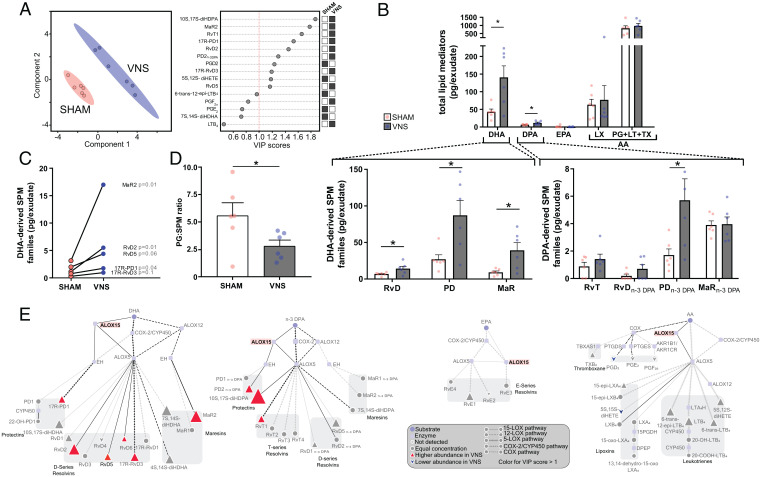Fig. 2.
VNS increased levels of lipoxygenase-derived SPM. Wild-type mice were subjected to either left cervical VNS or sham surgery followed by peritoneal injection of zymosan (0.1 mg/mouse). Levels of LMs in peritoneal exudates collected 12 h after intraperitoneal zymosan injection were measured using LC-MS/MS–based LM profiling. Concentrations of identified and quantified LMs were analyzed using PLS-DA, generating (A) a two-dimensional score plot showing a separation between VNS (blue) and sham-treated (red) groups (Left) and VIP scores of 15 LMs with the greatest contribution to the separation of the groups (Right). White squares indicate lower levels and black squares indicate higher levels in the sham or VNS-treated group. (B) Levels of total LMs identified in peritoneal exudate collected at 12 h after zymosan-induced peritonitis from the major bioactive metabolomes DHA, EPA, n-3 DPA, and AA (LX and PG + LT + TX). Levels of identified DHA-derived (Lower Left) and n-3 DPA–derived (Lower Right) SPM families in peritoneal exudates and VNS- (blue dots and gray bars) and sham-treated (red dots and open bars) mice are shown. (C) Levels of select DHA-derived SPM in sham- or VNS-treated mice. (D) Ratio of proinflammatory PGs to SPM in peritoneal exudates from VNS (blue dots and gray bar) and sham-treated (red dots and open bar) mice. (E) LM profiles in VNS- and sham-treated mice were investigated using an interaction network pathway analysis. n = 2 experiments. Data in B and D are shown as mean ± SEM. *P < 0.05.

